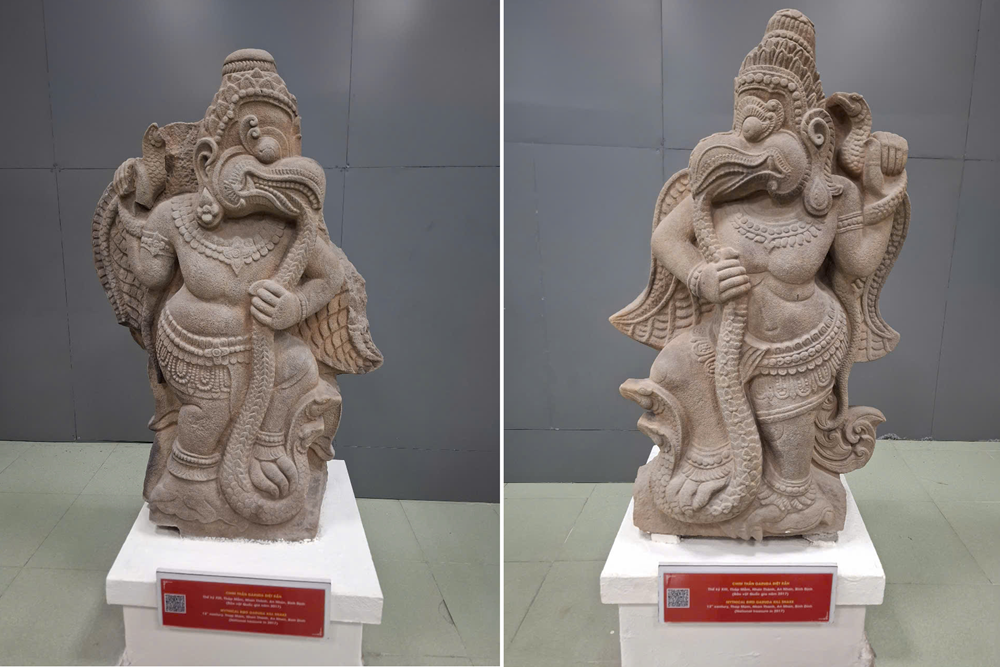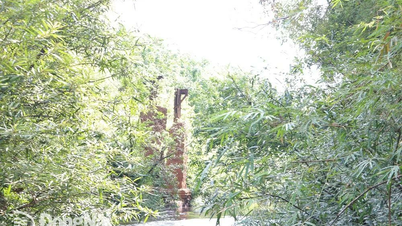VHO - The pair of statues of Garuda slaying a snake in Thap Mam is a wonderful testament to the combination of artistic talent and philosophical depth of Champa culture. Discovered in 2011 at the Thap Mam relic (An Nhon, Binh Dinh), this pair of statues was recognized as a National Treasure in 2017. Made of fine-grained silics stone and meticulously carved lines, the pair of statues is not only an artistic heritage but also a meaningful mythological story, depicting the harmony between strength and opposition, between light and darkness.

Mythology and Art: An Eternal Symbol
In Brahmanical mythology, Garuda is a divine bird, the king of all birds, and a symbol of light, power, and freedom. Garuda’s archenemy is the Naga, a serpentine creature that represents darkness and primal power. Legend has it that Garuda avenged his mother by destroying the Naga, and later became the mount of the god Vishnu. The relationship between Garuda and the Naga is not only a battle between good and evil, but also a symbol of balance in the universe.
The pair of Garuda slaying snake statues vividly depicts Garuda subduing Naga. Garuda stands upright, his wings spread wide as if he wants to pierce through space, his beak tightly biting the snake's body, his large, round eyes filled with determination. Below, Naga is being trampled by Garuda's foot, his body writhing but helpless. Every small detail such as the lotus petals on the Kirita-mukuta hat, the necklace, or the decorative beads are all elaborately carved, creating an amazing balance and harmony.
The war between light and darkness
The pair of statues not only depict a confrontation, but also convey a profound philosophy about balance in nature. Garuda is light, freedom beyond all constraints, while Naga is darkness, the latent power of nature. The two seemingly opposing elements complement each other, highlighting the philosophy of "good and evil co-exist" in Champa culture.
Garuda, with its majestic appearance, represents liberation, affirming that light and justice will always prevail. Meanwhile, the image of Naga, despite being subdued, still retains its soft beauty, is a reminder that darkness is not completely gone, but always exists as an indispensable part of the balance of the universe. This opposition, when expressed in art, has become a wonderful harmony between form and content, between beauty and sublimity.
Characteristics of Champa art: From shapes to sophistication
The pair of Garuda killing the snake statues of Thap Mam is the pinnacle of Champa sculpture, demonstrating talent and sophistication in every detail. The fine-grained silica stone material not only brings durability but also allows the artisans to clearly depict every line of the work. In particular, the stone surface is meticulously processed, creating a soft feeling despite the nature of the material being hard.
Details such as the round beads, the lotus petals on the Kirita-mukuta hat, and the curves of the wings and body of the snake all show meticulous care. These are not only decorative but also meaningful symbols: the round beads evoke eternity, the lotus petals represent enlightenment, while the curves of the snake's body emphasize the softness and movement of nature.
In addition to the balance of shapes, the pair of statues also brings harmony between opposing elements. Garuda's wide-spread wings seem to want to break the limits of space, while the winding snake body shows softness and flexibility. The combination of strength and flexibility, authority and grace has created a work that is not only aesthetically beautiful but also has depth of thought.
Cultural and spiritual values
The pair of Garuda slaying snakes is not only an artistic achievement but also a cultural symbol with profound spiritual meaning. In Champa culture, every detail on the statue is carved not only for beauty but also to convey philosophical and religious values. Garuda and Naga are not only two mythological characters, but also represent the intersection between humans and the universe, between the physical life and the spiritual world .
Recognized as a National Treasure, this pair of statues is not only a legacy of Champa but also a pride of Vietnamese culture. Every detail, from the large blocks to the small motifs, is a testament to the creativity and timeless thinking of Champa artisans. They not only depict a story, but also serve as a reminder of the harmony in nature and life.
Eternal Messages from Stone
The pair of statues of Garuda slaying the snake in Thap Mam is a work of art not only to admire but also to ponder. Through the hands of Champa artisans, stone is no longer an inanimate object but becomes a place of myth, a place where strength and harmony, light and darkness converge.
The work not only tells the story of the battle between good and evil, but also conveys the message of balance and harmony in the universe. This is the eternal value, the breath of Champa culture, and the endless inspiration for today's and future generations.
Source: https://baovanhoa.vn/van-hoa/cap-tuong-garuda-diet-ran-thap-mam-115443.html






























![[Photo] The 9th Congress of the Party Committee of the Office of the President, term 2025-2030](https://vphoto.vietnam.vn/thumb/1200x675/vietnam/resource/IMAGE/2025/6/20/78e7f27e8c4b4edc8859f09572409ad3)





















![[Maritime News] Wan Hai Lines invests $150 million to buy 48,000 containers](https://vphoto.vietnam.vn/thumb/402x226/vietnam/resource/IMAGE/2025/6/20/c945a62aff624b4bb5c25e67e9bcc1cb)














































Comment (0)